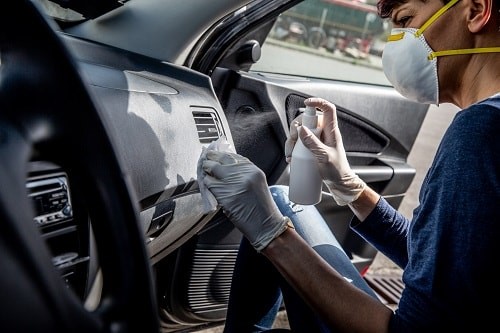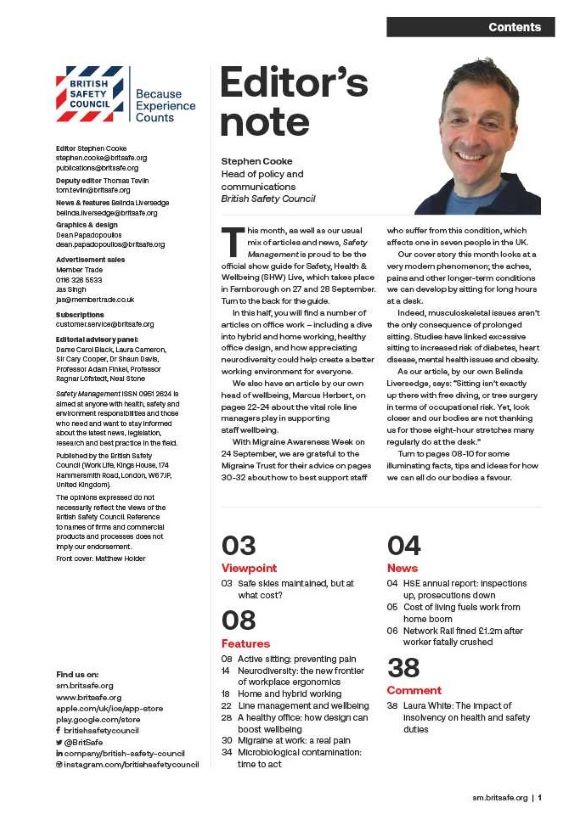Staff who drive as part of their work must be consulted on any rules designed to ensure safe driving, otherwise they will not be committed to following them.
Features
On the road
Driving is often seen as a consequence of a job rather than a safety-critical aspect, yet it is well-established as one of the highest risk activities that most employees will ever undertake. Failure to manage that risk doesn’t just put drivers and other road users at risk. It can put directors and senior managers, reputations and even the business itself at risk.
Government figures for road casualties show that in 2019 there were almost 40,000 deaths and injuries involving someone who was driving for work at the time.
However, it is rarely the driver who is the casualty. Roughly four out of five of those casualties were other, often vulnerable, road users such as pedestrians, cyclists and motorcyclists. In this magazine last month, for instance, it was reported that a transport firm had been closed down by the Traffic Commissioner after a young doctor was hit and killed while cycling by one of its lorry drivers.
 Road safety is not just about the driver, but also anyone whose role may impact upon the driver – such as line managers, work schedulers and vehicle engineers.
Road safety is not just about the driver, but also anyone whose role may impact upon the driver – such as line managers, work schedulers and vehicle engineers.
Another firm was fined £450,000, and ordered to pay a further £300,000 in costs, earlier this year after one of its drivers fell asleep at the wheel of his van, killing himself and his work colleague who was in the cab next to him.
The driver was on his way home after driving and working for 25 hours continuously at the time of the crash. His employer was found guilty of a number of breaches, including failing to follow its own fatigue management policies and failing to manage its drivers properly. The company’s fleet insurance policy stipulated a minimum age of 25, yet the driver was just 20 years old.
What should really focus everyone’s attention was that the investigation and prosecution, in this case brought by the Office of Rail and Road rather than HSE, took so long to complete. The incident itself happened in 2013 and so those responsible had the stress of an investigation hanging over their heads for a full seven years before being found guilty.
Why manage occupational road risk?
Work-related road risk is the likelihood of one of your staff being involved in an incident while driving as part of their job. This is something nearly every business has to manage, but the good news is that managing it well can bring significant benefits in terms of reducing risk, controlling costs and enhancing efficiency. In short – it makes good business sense.
To put the risk from driving at work into context, according to official figures, the odds of winning the jackpot in the UK’s National Lottery are one in 45 million. They’re not great odds yet millions of people across the country religiously buy a ticket every week because they think it might be them.
Yet, with around 20 million vehicles thought to be used for work, including those workers who use their own personal cars, and almost 40,000 casualties according to Department for Transport statistics, this means the odds that someone who drives for work will be involved in an injury collision during the year are just one in 500. Therefore, if you have 500 staff who drive for work, it is statistically likely that at least one of them will be involved in an injury collision during the year.
 Employers should clean their vehicle regularly to help reduce the spread of the coronavirus
Employers should clean their vehicle regularly to help reduce the spread of the coronavirus
We also know that collisions involving at-work drivers are under-reported because, in most cases, the purpose of the journey isn’t actually recorded. And none of this includes the millions of other ‘damage-only’ incidents that happen every year.
The human impact of these incidents can often be massive, with effects rippling out to secondary victims. These include family and friends, work colleagues and associates, and the emergency services who are required to deal with the aftermath.
Add in the less severe incidents, and the cost to the wider economy is literally billions of pounds from damage, repairs and lost productivity.
The cost to individual businesses can be significant, yet often unseen, and includes staff absence, increased maintenance costs, additional management time and higher fleet insurance.
If you employ van drivers, it is worth noting they are typically at much higher risk of being involved in an incident than car drivers and are often a moving billboard for the company they represent. We all know that brand protection is important in the same way that customer service and quality control are.
Where does the responsibility lie?
In truth, it is a shared responsibility between employers and employees. The provisions of the Health and Safety at Work Act 1974 apply to driving for work in the same way they apply to operating dangerous machinery. So it is just as important for the employee to observe and follow their company’s road safety policy as it is for the employer to assess the risk and set that policy.
Driving for Better Business is a free-to-access, government-backed Highways England programme to help employers in both the private and public sectors reduce work-related road risk, control the associated costs and improve compliance with current legislation and guidance. The Driving for Better Business vision is “a world where those who use the roads for work do so safely, efficiently, and sustainably”.
We therefore believe employers’ responsibilities can be separated out into three strands:
Legal – ensuring the company is operating in full compliance with current legislation and guidance
Moral – a strong safety culture that values worker safety, health and wellbeing, and
Financial – this means understanding that the effective management of those who drive for work directly impacts on the efficiency and performance of the company.
This is then all wrapped up with strong leadership where those at the top demonstrate these three imperatives at every opportunity. This means stating the importance of the three road safety principles to the business and leading by example with commitment and authenticity.
Good leaders recognise that effective management of people is central to the success of any organisation – and can yield significant benefits in terms of business performance, cost efficiency and staff wellbeing. When it comes to driving for work, it’s not just about management of drivers, but anyone whose role may impact upon the driver – such as line managers, work schedulers and vehicle engineers.
Evaluate practices (legal)
All of this may sound simple and obvious to an experienced safety professional but the finer points of how this applies in practice are often misunderstood by senior management. This can lead to critical gaps appearing in your road risk management policies and procedures.
The two prosecutions referenced at the start of this article demonstrate that the police and the judiciary are increasingly realising that incident accountability doesn’t rest solely with the driver and they are now looking further up the operational chain of command.
In fact, research carried out by Driving for Better Business last year highlighted two alarming trends.
The first was that board directors often had a very poor understanding of both the law and their responsibilities. For example, of the 255 board-level executive directors we surveyed, 53 per cent incorrectly believed employees who use their own personal car to drive for work purposes were not the company’s responsibility. Also, almost two thirds were unsure how many, if any, staff used their own cars for business journeys.
In this case, the ownership of the vehicle is largely irrelevant and, if the journey is required by the employer for work purposes, the employer has an obligation to ensure it is carried out safely and legally. What made our findings even more concerning was that, of more than 1,000 drivers surveyed, 90 per cent said they used their own car for work at least occasionally (with some every day) – yet a third of these admitted their car insurance did not cover them to make those journeys. In short, these employees were effectively driving on company business while uninsured.
Strengthen culture
Meaningful risk reduction and improvements in business performance rely on a strong culture within the organisation, where people throughout the organisation accept a shared responsibility to ensure work is completed safely and efficiently.
So, how can we cultivate a healthy culture? How can we help drivers to treat driving as a professional aspect of their job? We suggest using the following formula: empowerment x education ÷ incident investigation.
Empowerment x education
In terms of education, we need to make sure that our drivers know what they need to know, but also know the company’s expectations of them – which is, of course, safety first.
Education needs to be paired with empowerment to result in any meaningful influence over safety culture. Empowerment can be found in high quality driver coaching but is also found in two other key areas: leadership and consultation.
Consultation with the company’s drivers is required to truly understand the challenges they face. It must be followed by collaboration with them to build the processes and procedures that mitigate road safety risks and improve efficiency. The results of the consultation with company drivers should also influence the content of any driver safety training.
Engaging drivers when developing road safety policies and procedures has the potential to deliver outstanding results. If you develop the driving safety rules in partnership with your drivers, they are more likely to accept and comply with them, as they have been involved in drawing them up.
As a result, you will generally have to spend less time in enforcing those rules.
On the other hand, if you set and enforce the rules arbitrarily, this can lead to unhappy drivers who are more likely to break the rules. This is because they feel they had no say in drawing them up, and may disagree with the need for them and question their effectiveness.
Also, leadership starts with leading by example. For instance, a manager who calls drivers while driving and expects the call to be taken, not only undermines your policy in never using a mobile phone while driving, but erodes all safety values that the driver has developed.
Incident investigation
Although the aim should always be ‘zero incidents’, even with a strong company road safety policy and procedures, incidents can happen. How an employer responds to incidents is critical to the effectiveness of the organisation’s road safety culture. All incidents must therefore be fully investigated.
However, the aim of the investigation must be to attempt to understand what went wrong, rather than to apportion blame. Things not going to plan (i.e. incidents) can be graded as:
- Driver did not know the correct thing to do – this means there is a need for driver education
- Driver knew the right thing to do and did something else – you need to investigate why the driver did this
- Was the driver’s decision made for personal gain, such as driving too fast to finish work earlier than they were scheduled to? You need to re-educate the driver on the company’s expectations on road safety and consider disciplining them.
Improve performance
If company vehicles aren’t managed properly, the cost of operating a fleet can be far higher
than necessary.
For example, an unsafe driver, who regularly speeds and lacks care and attention while on the road, can typically cost the business much more in fuel, tyres, routine servicing and maintenance, fleet insurance and collision damage.
However, taking steps to prevent work-related road crashes and ensuring staff always drive in a safe manner can result in a number of business benefits. These include improved brand image, more reliable delivery of services (for example, because delivery vehicles are not off the road due to damage from collisions), better overall business efficiency and reduced environmental impact.
Driver safety concerns during the Covid-19 pandemic
In the midst of the stress associated with running a business during the pandemic, it can be all too easy to let normal road safety procedures fall by the wayside. So when it comes to following your policies and procedures around driving for work, there are several different housekeeping areas to think about.
Particularly pertinent areas include preventing and managing driver fatigue, which may be more important than ever, if drivers are working longer hours than normal in order to deliver key work during the crisis.
Businesses also need to think about the upkeep and maintenance of vehicles. Again, these procedures may have been disrupted due to the lockdown when over five million MOTs were missed, including for 1.2 million vans.
The government automatically extended by six months the MOTs of vehicles that were due to expire in the period 30 March to 31 July 2020. This means that many vehicles will not have to undergo an MOT until as late as 31 January 2021.
However, these MOT extensions do not take away an organisation’s responsibility for ensuring that their vehicles are roadworthy.
Employers also need to follow the relevant government guidance on undertaking regular cleaning of their vehicles to help reduce the spread of coronavirus, including after different drivers and passengers have used them.
Also, if your work has expanded in say, home delivery, then it is important to maintain thoughtful and comprehensive driver safety induction processes. Even if you need to quickly recruit drivers to meet increased demand, your duty of care for drivers’ safety remains unchanged, and this includes providing them with suitable health and safety training so they remain safe on the road.
For advice and a free Gap Analysis see: drivingforbetterbusiness.com
FEATURES

Why line managers play a vital role in workplace wellbeing
By Marcus Herbert, British Safety Council on 03 September 2023
The behaviours of line managers can have a positive or negative impact on employee health, wellbeing and engagement, so it’s vital managers get staff feedback on whether their management style is supportive or negative, and have regular check-ins so workers can raise concerns about their wellbeing.

Watercooler Event to hone in on eight trends in employee health and wellbeing
By Claire Farrow, Make a Difference Events & Media on 15 April 2024
The free-to-attend Water Cooler Event at ExCeL London on 23–24 April will see more than 6,000 workplace experts coming together to explore the latest thinking, solutions and best practice for supporting and boosting employee wellbeing, diversity and workplace culture.

Sedentary working and how to combat the ‘sitting disease’
By Gavin Bradley, Active Working on 05 April 2024
Prolonged and excessive sitting poses a major risk to our health, but the Get Britain Standing campaign and On Your Feet Britain Day on 25 April are a great way of encouraging workers to sit less and move more.



